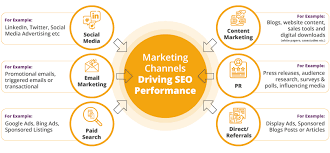The Importance of SEO in Web Design
When it comes to creating a successful website, incorporating SEO (Search Engine Optimization) into the web design process is crucial. SEO plays a significant role in determining how well your website ranks on search engine results pages, ultimately affecting your online visibility and traffic.
Why is SEO Important in Web Design?
Here are some key reasons why integrating SEO into your web design strategy is essential:
- Improved Visibility: By implementing SEO best practices in your web design, you increase the chances of your website appearing higher in search engine results, making it more visible to potential visitors.
- User Experience: SEO-friendly web design focuses on creating a seamless user experience by ensuring that your site is easy to navigate, loads quickly, and provides valuable content that meets users’ needs.
- Targeted Traffic: Optimizing your website for relevant keywords and phrases helps attract targeted traffic that is more likely to convert into leads or customers.
- Mobile-Friendly Design: With the rise of mobile usage, having a responsive web design that is optimized for mobile devices not only improves user experience but also boosts your site’s SEO performance.
Key Elements of SEO-Friendly Web Design
To ensure that your website is well-optimized for search engines, consider incorporating the following elements into your web design process:
- Keyword Research: Identify relevant keywords and phrases that align with your business goals and target audience.
- Title Tags and Meta Descriptions: Craft compelling title tags and meta descriptions for each page to improve click-through rates from search results.
- Optimized Images: Use descriptive filenames and alt text for images to enhance accessibility and improve image search rankings.
- User-Friendly URLs: Create clean, concise URLs that include relevant keywords for better search engine visibility.
In Conclusion
Incorporating SEO principles into the web design process is essential for creating a successful online presence. By focusing on user experience, targeted keywords, and technical optimization, you can enhance your website’s visibility and attract more organic traffic. Remember, effective SEO starts with thoughtful planning during the web design phase and continues with ongoing optimization efforts to stay ahead in the competitive online landscape.
Top 6 Essential Web Design SEO Tips for Enhanced Visibility
- 1. Use relevant keywords in page titles and meta descriptions.
- 2. Create unique and descriptive URLs for each page of your website.
- 3. Optimize images by using descriptive filenames and alt text.
- 4. Ensure your website loads quickly to improve user experience and SEO performance.
- 5. Include internal links to connect related content within your website.
- 6. Regularly update and add fresh content to keep your website relevant and engaging.
1. Use relevant keywords in page titles and meta descriptions.
To enhance your website’s search engine visibility, it is essential to utilise relevant keywords in both page titles and meta descriptions. By incorporating targeted keywords that align with your content and audience’s search intent, you can improve your chances of ranking higher in search results. Page titles and meta descriptions serve as concise summaries of your web pages, making them crucial elements for attracting clicks from users browsing search engine results. Ensuring that these elements are optimised with the right keywords can significantly impact your website’s SEO performance and overall online visibility.
2. Create unique and descriptive URLs for each page of your website.
Creating unique and descriptive URLs for each page of your website is a crucial tip for effective web design SEO. By crafting URLs that accurately reflect the content and purpose of each page, you not only enhance the user experience but also provide search engines with valuable information to index and rank your site. Clear and keyword-rich URLs can improve your site’s visibility in search results, making it easier for both users and search engines to understand the relevance of your content. Remember, thoughtful URL structure is an important aspect of on-page SEO that can contribute to the overall success of your website.
3. Optimize images by using descriptive filenames and alt text.
To enhance your website’s SEO performance, it is crucial to optimise images by using descriptive filenames and alt text. By incorporating relevant keywords into the filenames and alt text of your images, you not only improve accessibility for visually impaired users but also provide search engines with valuable information about the content of the image. This practice can help boost your site’s visibility in image search results and contribute to overall SEO success.
4. Ensure your website loads quickly to improve user experience and SEO performance.
Ensuring that your website loads quickly is a critical aspect of web design SEO. A fast-loading website not only enhances user experience by providing visitors with instant access to content but also positively impacts SEO performance. Search engines like Google consider page speed as a ranking factor, so optimising your site’s loading time can help improve its visibility in search results. By prioritising speed in your web design efforts, you can create a seamless browsing experience for users while boosting your site’s chances of ranking higher in search engine listings.
5. Include internal links to connect related content within your website.
To enhance the SEO performance of your website, it is advisable to include internal links that connect related content within your site. By strategically linking relevant pages together, you not only provide a seamless navigation experience for users but also help search engines understand the structure and hierarchy of your website. Internal linking can improve the discoverability of your content, distribute link equity throughout your site, and ultimately boost your website’s overall SEO ranking.
6. Regularly update and add fresh content to keep your website relevant and engaging.
Regularly updating and adding fresh content to your website is a crucial aspect of effective SEO in web design. By consistently refreshing your site with new and relevant content, you not only signal to search engines that your website is active and up-to-date but also provide value to your visitors. Fresh content keeps users engaged, encourages return visits, and can improve your site’s search engine rankings by demonstrating authority and expertise in your field. In the dynamic online landscape, staying current with regular updates is key to maintaining a competitive edge and ensuring that your website remains relevant and appealing to both users and search engines alike.




